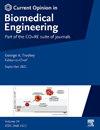Personalized gait rehabilitation with spinal cord stimulation and machine learning: Recent advances and promising applications
IF 4.2
3区 工程技术
Q2 ENGINEERING, BIOMEDICAL
引用次数: 0
Abstract
Lumbosacral spinal cord stimulation shows promise in restoring walking after spinal cord injury. This review discusses recently developed machine learning approaches to provide customized stimulation patterns and parameters according to the extent of injury to achieve community ambulation. Key challenges include the need for control strategies that enhance residual limb function and adapt to variable motor impairments across individuals. Efficient identification of optimal stimulation parameters and the ability to adapt parameters over time without manual tuning is essential for long-term use upon clinical translation of spinal cord stimulation therapies for rehabilitation. Machine learning provides the necessary framework for personalized rehabilitation treatment by offering a flexible architecture that evolves and adapts automatically to suit individual patient rehabilitation needs and preferences.
个性化步态康复与脊髓刺激和机器学习:最新进展和有前景的应用
腰骶脊髓刺激显示脊髓损伤后恢复行走的希望。本文讨论了最近开发的机器学习方法,根据损伤程度提供定制的刺激模式和参数,以实现社区活动。关键的挑战包括需要控制策略,以增强残肢功能和适应不同个体的运动损伤。有效地识别最佳的刺激参数和不需要手动调整的随时间适应参数的能力对于长期使用脊髓刺激康复治疗的临床翻译至关重要。机器学习为个性化康复治疗提供了必要的框架,提供了一个灵活的架构,可以自动发展和适应个体患者的康复需求和偏好。
本文章由计算机程序翻译,如有差异,请以英文原文为准。
求助全文
约1分钟内获得全文
求助全文
来源期刊

Current Opinion in Biomedical Engineering
Medicine-Medicine (miscellaneous)
CiteScore
8.60
自引率
2.60%
发文量
59
 求助内容:
求助内容: 应助结果提醒方式:
应助结果提醒方式:


